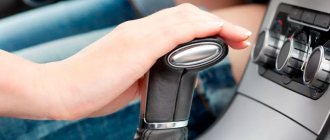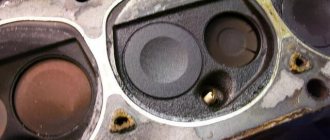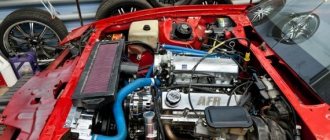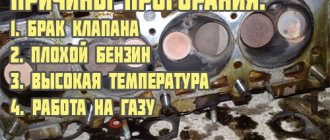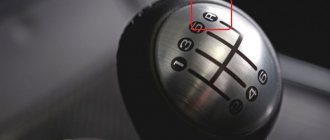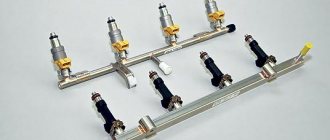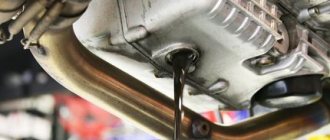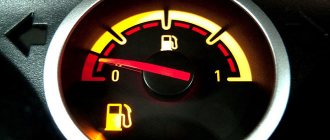The nozzle on a car's injection engine plays a decisive role in the stability of its operation. It is no less important than spark plugs or pistons, since without proper fuel injection it is impossible to detonate at a strictly specified moment. The injector injects fuel into the combustion chamber of the engine in a certain volume, which allows you to maintain the most economical and productive operating mode of the internal combustion engine. The vehicle's electronic control unit regulates the amount of fuel supplied by the injector.
Signs of a faulty injector
If problems arise with the stability of the engine, then it is impossible to say unequivocally that the injector or any other component is to blame.
It is necessary to check the ignition coil, spark plugs, cylinder compression and other components that are responsible for detonation in the combustion chamber, including injectors. Here are just a few of the problems that indicate faulty injectors:
- The car engine shows unstable operation at idle;
- Fuel consumption has increased significantly;
- There are problems starting the engine;
- The car has lost its dynamics, and when overtaking or sharp acceleration, you feel a lack of power and engine jerking.
If there are similar problems in your car, you can start diagnosing the engine by checking the injector. There are several methods for checking injectors without removing them from the engine, and they will be discussed below.
The main causes of injector contamination.
But the injectors of cars that are operated in the territory of the former USSR have to be cleaned every 15 - 30 thousand kilometers. There is only one reason for the poor quality of fuel - the desire to receive excess profits from the sale of fuel and lubricants. As a result:
- Insufficient capacity for the production of A-92 and A-95 gasoline, but A-98 at domestic gas stations is in most cases a myth and a cunning marketing ploy - nothing more;
- Violation of fuel storage conditions. Often, the same tanks are used to store gasoline A-76, A-80, A-92, A-95, A-98, in which various tar deposits accumulate over the years of operation, dissolved by fuel with a higher octane number. As a result, tar deposits are washed into the tanks of our cars, leading to failure of the fuel system;
- The use of manganese-containing additives in the production of fuel, which increase anti-knock resistance. These are so-called anti-knock agents, which allow you to turn low-octane gasoline into high-octane gasoline with a slight movement of the hand. For example, an A-80 can “by magic” become an A-95, and there will be no detonation and its consequences as such. The additives, in turn, cause increased wear of the spark plugs and accelerated contamination of the fuel filter with fine brick-colored particles.
All these reasons lead to the need to replace spark plugs, clean the injector, and in some cases even overhaul the engine.
How to check injectors without removing them from the engine using a multimeter
The diagnostic device multimeter is a faithful assistant to any motorist. It allows you not only to check fuses or the battery, but also to diagnose injector malfunctions. To check the injectors with a multimeter you need to do the following:
- Remove the high voltage wires from the injectors and consult your vehicle's manual to determine whether your engine has high impedance or low impedance injectors - this will be necessary for accurate diagnosis;
- Set the multimeter to resistance measurement mode and connect the diagnostic wires to the injector terminals, then take the measurement;
- If your vehicle has high impedance injectors, the measured resistance should be between 12 and 17 ohms. In the case where low impedance injectors are used on a car, their resistance lies in the range from 2 to 5 ohms.
In a situation where the indicators differ from the recommended ones, you should remove the injector from the car and check it in more detail, and if necessary, replace it.
Checking pump injectors: software diagnostics and measurement with a multimeter
In this article we will talk about such a procedure as checking pump injectors using software diagnostics and measuring with a multimeter.
But, before delving into the processes, you need to understand the basic terms. So, a pump injector is nothing more than an integrated direct fuel injection system under pressure in a diesel engine.
This pump injector is used mainly on all diesel engines, such as:
The most common for passenger cars are TDI from VW-Audi. But, they are gradually being forced out of development by the Common Rail system.
First of all, the cardinal difference between a pump injector and a Common Rail (in addition to a mechanical drive) is the combination of functions such as creating and maintaining high pressure and simultaneous fuel injection.
The pump injector mechanism itself is:
- High pressure pump;
- nozzle;
- actuator;
- dosing valve unit.
An experienced mechanic will tell you that the mechanical part of the pump injector control is nothing more than a distant relative of the gas distribution mechanism part. But there is an important difference between them in that the work is started using diesel fuel under very high pressure. This fact makes it possible to increase the operating power of the engine and thereby the torque.
Algorithm for the functioning of pump injectors:
- The ECU transmits a signal to the electromagnet, due to which the valve moves and the working chamber closes while simultaneously cutting off the fuel from the working line.
- Next, the plunger organizes such a pressure force that gives the desired fuel injection.
- After the fuel injection passes through the nozzle, a fuel cloud is created, after which the main injection is formed.
It follows from the algorithm that the most susceptible to failure are:
The main types of problems with diesel pump injectors:
- incorrect or difficult starting of the car;
- increased fuel consumption;
- uneven engine operation or loss of power;
- smoky exhaust on startup.
Technical process for checking the pump injector
Probabilities of failure of the pump injector components:
- Valve assembly - 63%.
- Spray - 30%.
- Electromagnetic part - 5%.
- Plunger, spring, housing - 2%.
Checking the pump injector:
Ideally, injector testing should be done on a specialized injector testing stand. But if it is not possible to get service at a service center, you can make do with garage conditions.
The simplest way to diagnose the condition of the pump injector is to carefully pinch the return hose on the fuel filter . In this manipulation there are three options for the development of events:
- If operation very slowly returns to normal mode, this means that most likely air bubbles are forming in the nozzle. This process begins when the tandem pump does not develop the required pressure or does not reach the design capacity.
- If you feel an increase in pressure inside, this indicates that the rubber connection at the junction between the incoming channel and the return of the pump injector is leaking.
- And the final situation may be one where nothing happens at all. Such a development of the situation can only be observed when the tandem pump fails.
A brief description of diagnosing the operation of unit injectors using VCDS software:
First of all, we take readings from channels 13 and 14 in the “Engine control unit” column. It is important that the spray correction indicators are directed towards 0.
Connecting the injector pump connector
Based on the indicators, you can determine the condition of the injectors: the injector itself is clogged or the valve assembly is not working correctly. If, after an incorrect start and further normal operation, the readings on the cylinders are more than 2.5 mg, this means that urgent repair of the pump injector is necessary.
There is another effective way to check the resistance of the solenoid valve coil , which is applicable when there are any doubts about the operation of the pump injector.
Failure can be signaled by the supply of diesel fuel to the return line. It is important that the operating resistance of the coil is approximately 0.5 ohms.
In conclusion, to summarize all of the above, modern piezo injectors in most cases require replacement with completely new ones.
The electromagnetic type of pump injectors has the right to repair in cases where the sealing ring is slightly worn, slightly dirty, or the nozzle is damaged. A situation where only replacement is necessary is wear of the EMC and the locking spool.
Source
Checking the injectors without removing them from the engine by ear
If you consider yourself quite experienced in diagnosing car malfunctions, you can try to identify problems with the injector by sound. With the engine running, listen carefully to the sounds coming from the cylinder block. A dull ringing sound indicates that there are problems with the engine injectors. In such cases, it is recommended to clean the injectors.
Determining damage by hearing
Most experienced drivers can try to determine the operation of the injectors even by ear. Beginners are not recommended to use this method due to lack of experience.
To try to diagnose injectors by ear without removing them from the engine, you will ideally need a stethoscope or a small thin board. One side of the board must be pressed tightly against the TF being examined, and we place our ear on the other side.
When working properly, the nozzle does not emit any extraneous sounds, does not emit vibration, and generates rhythmic clicks extremely clearly. If uneven noises or knocking noises are heard, we can conclude that the nozzle is clogged. The degree of damage is determined by the volume and frequency of the unusual noise.
Motorists with extensive experience can do without a plate during analysis. If a malfunction exists, a muffled high-frequency sound will emanate from the engine area, very much like a squeak. If it is continuously heard while the engine is running, then the fuel injectors must be examined on a ramp or stand.
Checking the mechanical properties of the injector
It is quite difficult to check the mechanical properties of injectors on your own, given the need for specific equipment to carry out such procedures. Many auto repair shops have special stands for checking the mechanical properties of injectors. With their help you can determine:
- What fuel flow passes through the injector when the engine is running;
- What does the “torch” of fuel spray from an injector look like when the engine is running. If the fuel is not flowing evenly through the injector, there is a good chance that it needs to be cleaned.
Checking the mechanical properties of the injector is the most accurate method for diagnosing this component of an internal combustion engine.
Comprehensive diagnostics of the operation of injectors on the ramp
For such a check, the fuel rail will need to be removed from the engine along with the injectors attached to it. After this, you need to connect all electrical contacts to the ramp and injectors if they were disconnected before removal. It is also necessary to return the negative terminal of the battery to its place.
- The ramp must be placed in the engine compartment so that a measuring container with a scale can be placed under each of the injectors.
- It is necessary to connect the fuel supply pipes to the ramp and additionally check the reliability of their fastening.
- The next step is to turn on the ignition, after which you need to crank the engine a little with the starter. This operation is best performed with an assistant.
- While an assistant rotates the engine, check the efficiency of all injectors. The fuel supply must be the same on all injectors.
- The final step will be to turn off the ignition and check the fuel level in the containers. The specified level must be equal in each container.
In addition to self-checking, you can use the injector diagnostic service at a car service center. This operation is performed on a special testing stand. Testing an injector on a bench allows you to accurately determine not only the efficiency of fuel supply, but also the shape of the torch during fuel spraying.
How to clean injectors without removing them from the engine
If a malfunction of the engine injectors is diagnosed, it is possible that they are dirty. To correct the situation without removing the injector from the engine, you can:
Use specialized engine cleaning additives that are poured into the fuel tank;- To keep engine injectors clean, experienced drivers recommend cleaning them monthly using pressure. To do this, you need to accelerate the car on a flat road to a speed of 120 kilometers per hour. In this mode, you need to cover 10-15 kilometers, after which you can slow down;
- If you do not have the opportunity to drive the car at high speeds, you can use another method of cleaning the injectors without removing them from the engine. It is necessary to maintain the vehicle idle speed at 4-5 thousand for 3 minutes. This method of cleaning injectors is less effective than the options listed above.
Which indicates possible problems with the injector
Let us immediately note that there can be many reasons for unstable engine operation, ranging from a clogged fuel filter, a broken fuel pump, a failed spark plug or a faulty coil, to loss of compression, problems with the timing belt, etc. Along with this, one of the main signs of injector malfunction is difficulty starting the engine, especially when cold, as well as gasoline or diesel consumption (depending on the engine type), which increases noticeably. It is also necessary to note the unstable operation of the internal combustion engine in idle mode, similar to the so-called “triple” of the engine.
When driving, it is possible that one or several symptoms may occur quite frequently:
- presence of jerks, very slow reactions when pressing the gas pedal;
- obvious failures and loss of dynamics when trying to accelerate sharply;
- the car may jerk while driving, when releasing the gas, and also after changing the load mode on the engine;
It must be added that such a malfunction must be corrected immediately, since problems with the injector negatively affect not only the service life of the engine and transmission, but also overall traffic safety. In a vehicle with faulty injectors, the driver may experience serious difficulties when overtaking, on steep hills, etc.
How to check engine injectors?
The injector is a key element of the fuel system. Structurally, it is a valve operating on an electromechanical principle. As soon as voltage is applied to the injector winding, an electromagnetic field is formed, retracting the core and needle of the locking mechanism. At this moment, the fuel mixture, under pressure, is supplied to the combustion chamber of the corresponding cylinder. To clean fuel from “garbage”, a filter element is installed at the inlet of the device.
The stability and service life of the engine depends on the serviceability and correct operation of the injector. When the pressure decreases, at the moment the injector opens, fuel is injected ahead of time, and black smoke comes out of the exhaust pipe. In the opposite situation, when the opening of the nozzle is accompanied by an increase in pressure, injection occurs with a delay. This problem is diagnosed by the appearance of white smoke.
To prolong the life of the engine and fuel system, it is important to know how to check the injectors and what signs can be used to recognize their malfunction. We will consider these points in the article.
How to identify a faulty injector?
An injector malfunction can be diagnosed by the following symptoms:
- Slowdown of the engine starting unit, which most often manifests itself in the cold season.
- The appearance of dips and jerking of the car when accelerating (accelerating) or when changing transient conditions.
- Increased engine "gluttony" (fuel consumption increases).
- Power drops and dynamic qualities deteriorate, which is especially noticeable during the acceleration of the car.
- Dips occur when the engine is idling.
If one or more of the listed symptoms appears, it is important to check the injectors and fix the problem. If you don't take action, your car may need expensive repairs. Watch the video “How to Test an Injector” below.
Is it possible to check the serviceability of the injectors without removing them from the engine? Today there are several ways to identify a problem with one or more injectors at an early stage.
METHOD ONE - measure the resistance on the injector windings. To begin with, turn off the ignition and remove the terminals from the car’s battery (just remove the negative wire). Then proceed like this:
- Using a thin-bladed screwdriver or an awl, unclip the spring-type clamp installed on the block.
- Discard the connector from the injector, and connect a measuring device (ohmmeter) to the terminals of the device. Record your readings.
- If the resistance level between the pins (side and center) is 11-15 Ohms, then the injector is coping with the task normally. If the measured parameter is higher or lower than normal, replace the nozzle.
METHOD TWO - checking all injectors. To check the injectors as a whole, you cannot do without dismantling the fuel rail, where they are all attached. After removing the ramp, connect the block with wires to the harness. Next, return the negative terminal to the battery (if it was removed earlier). Now do this:
- Connect fuel pipes to each other. To do this, use a wrench, and with its help, secure the fittings.
- Place a marked container under each of the injectors, which will allow you to accurately measure the amount of fuel released.
- Crank the engine by turning the key in the ignition. It is more convenient if an assistant performs this work, and your task is only to check the injectors for serviceability. Ideally, fuel comes out evenly from each device.
Afterwards, turn off the ignition and estimate the amount of fuel that has dripped into the measuring containers. If all nozzles are working properly, the liquid level will be almost identical. If there is less fuel in any of the vessels, then change or clean this nozzle. Most likely it is clogged or faulty.
Finally, inspect the condition of each of the injectors for any defects or external flaws. Pay attention to the spray part - there should be no traces of fuel leakage on it when the ignition is turned off. If such problems are found, it means that the nozzle is not sealed and requires replacement.
Cases when the nozzle needs to be completely replaced
Let's list the main features:
- the resource declared by the manufacturer has been exhausted;
- there are breakdowns or other leaks in the housing;
- burnt nozzle nut: if the problem is not corrected at an early stage, the nozzle itself will become unusable.
Please note that on some engines, after installing a new injector, it is necessary to “bind” it to the engine: make changes to the settings of the control unit.
It is better to install the nozzle at a service station, since the station has bench equipment for adjusting and assessing the current condition of the part.
Why don't the injectors work?
Nowadays, injectors are made to a tolerance of 1 micron, which allows them to carry out about a billion cycles. The main reason why their performance is impaired is contamination during operation , despite the fact that the path to any mechanical particles is blocked by filters that filter out particles larger than 10-20 microns. The place where the filters are installed is the fuel line and the injector itself. The main cause of contamination is the inevitable presence of heavy particles in the fuel. The largest accumulation of dirt occurs after the engine is turned off. At this moment, due to the fact that the nozzle is heated by the engine, the temperature of its body increases, while there is no cooling effect of the fuel. Light particles of fuel located in the nozzle evaporate, while heavy ones settle like varnish deposits, reducing the cross-section in the calibrated channel. For example, deposits 5 microns thick can reduce the capacity of a given channel by about 25%. Contamination of the holes in the injectors prevents the formation of the fuel mixture, the shut-off valve of the pressure regulator loses its tightness, and the high-pressure fuel pump in diesel engines reduces its performance.
Prevention is better and cheaper than treatment!
It should be noted that, as with most technical issues. vehicle maintenance, prevention is always better and cheaper than treatment (repair). One of the simplest, cheapest and most effective ways to prevent fuel injection problems is to maintain a healthy ignition system. One of the most important conditions for the “health” of injectors is cleanliness! It is important to refuel with high-quality fuel and change filters on time. Also, to prevent contamination of injectors, as well as combat deposits, experts recommend using a special liquid to clean fuel injectors. In addition, there is a “flush” that allows you not only to prevent the accumulation of dirt and deposits, but also to completely clean the fuel injector system.
Fuel Injector Cleaner is a fuel additive that is easy to use and great for preventative maintenance. At the same time, it is relatively inexpensive, especially when compared with engine repair or replacement of injectors. Some mechanics recommend using flushing fluid every time you fill up, but if you are confident in the quality of your fuel, this is unlikely to be necessary. In all other cases, if you notice any of the above symptoms, use a flush to prevent more serious problems. It is also a good habit that many motorists have - using injector flushing additives every time they change the engine oil.
If your problem is more serious, then you will most likely need to consider having your fuel injectors professionally cleaned. Of course, this will cost much more than flushing liquid, but the result will be much better. And besides, it is much cheaper than replacing injectors or repairing the engine.
Signs of faulty fuel injectors
The main signs of clogged injectors are difficulty starting the engine; interruptions in engine operation at idle and transient mode; failures when the gas pedal is pressed too sharply; engine power is lost and acceleration dynamics deteriorate; fuel consumption increases; the toxicity of exhaust gases increases; detonation that occurs when the engine accelerates due to an increase in temperature in the combustion chamber; misfire; exhaust system pops; breakdown of the sensor that determines the oxygen level, as well as failure of the catalytic converter. When the frosty season sets in, problems with injectors are especially noticeable - a cold engine rarely starts normally.
There are two ways to clean fuel injectors:
- Cleaning injectors without removing them from the engine.
- Cleaning on an ultrasonic rack with preliminary dismantling of nozzles.
cleaning method more effective than flushing without dismantling, but the first method also cleans other parts of the system, such as the ramp, shut-off and inlet valves, high pressure pump, etc. The cost of cleaning largely depends on the engine itself, and is $10-30 per nozzle. For some domestic and foreign cars, is more economical to install new injectors than to clean old ones.
Design
The injector is the most important element in the injection system of gasoline engines. This is a solenoid valve that operates “under the command” of the ECU, the electronic engine control unit. After receiving pulses of a certain frequency, the ECU “measures” the dose of the required fuel, depending on the engine load and coolant temperature. The precise and well-functioning operation of this mechanism allows the engine to operate properly for a long time: lower fuel consumption, greater power and torque, easy engine starting at any temperature - all these are advantages of the well-functioning operation of the injector, but any malfunctions in its operation worsen the performance of the entire engine. Very often, the faulty operation of a gasoline engine is caused by electromagnetic injectors that do not perform their functions or are partially faulty. This is due to the fact that there is no electrical impulse to open the valve, perhaps the solenoid winding has broken, or the internal valves may be dirty. Dirty internal valves most often make themselves felt to the car owner in winter when starting an injection engine.
How to clean injectors
It has been proven that regular use of high-quality chemicals every 5,000 kilometers, which is poured into the fuel tank to flush the fuel system and remove carbon deposits, ensures long-term uninterrupted operation of the injectors and the fuel system as a whole, but this is only true for new cars and with regular use, and when signs of malfunction are already appearing, then it’s a direct road to a car service center.
Today, auto repair shops widely use inexpensive single-circuit units, which are containers containing a solvent, located on a mobile stand next to the engine or under the hood of the car. The working principle of this single-circuit installation is as follows.
A pressure hose is connected to the fuel rail at the inlet. The solvent, which serves as both a cleaning agent and a fuel, is drawn from the container by increasing the pressure created by an air compressor attached to the solvent container. disadvantage is that the cleaning liquid bypasses the pressure regulator , thereby not cleaning its shut-off valve and very superficially flushing the fuel rail. Moreover, there is no way to check the result of washing using diagnostics; it is completely absent on installations of this class. It is also not uncommon to use solvents of dubious origin with very low cleaning abilities. This is done in order to minimize costs and maximize profits. An example can be given of a case where workers at a well-known service station washed injectors using the most ordinary gasoline, passing it off as a special high-quality cleaning liquid. Naturally, no benefit was observed from this cleaning.
How to clean the fuel supply device yourself
The same stand has a nozzle cleaning function. But if desired, this can be done in a garage. A standard cleaning liquid and a simple device assembled from improvised materials are used.
The homemade installation is a car electric fuel pump placed in a vessel with injector cleaner. The hose from the pump is connected to the injector inlet fitting, and power from the battery is supplied to its supply connector through a push-button microswitch.
This is interesting: How to properly tow a car with automatic and manual transmission
By repeatedly driving a liquid containing powerful deposit solvents through a sprayer, you can achieve a significant restoration of the spraying properties of the device, which will become clear from the change in the shape of the torch.
An injector that cannot be cleaned will have to be replaced; its defect is not always associated with contamination; corrosion or mechanical wear is possible.
Flushing the fuel system as a whole
It is recommended to flush the fuel system every time after 15-20 thousand kilometers, and in most cases the problems described above simply will not arise. For diesel engines that operate with domestic diesel fuel (diesel fuel, which contains about 2% sulfur), the mileage from flush to flush is 10 thousand kilometers.
Society is asking a very pressing question -
what to wash with? Cleaning liquids are produced by many manufacturers. After conducting many tests and experiments, Russian products, such as “Moidodyr” or “Toilet Duckling”, unfortunately, cannot boast of quality. More or less high-quality solvents, according to some experimental companies, are produced by Germany (LIQUI MOLY), Belgium (WYNN*S), USA (HI-GEAR). The best, according to the results of independent tests carried out, is the American cleaning fluid. In terms of its ability to remove old deposits and cleaning properties, this solvent turned out to be 25% better than other solvents in its task. After the installation has completed its operation , it is recommended to continue the cleaning procedure by driving 10 km at high speed, with temperature and pressure serving as a catalyst, i.e. During movement, sludge softened by a solvent is removed from the fuel system, combustion chamber, intake valves and piston group heads. After the flushing is completed, it is strongly recommended to change the oil filter and engine oil, due to the fact that a small amount of special cleaning fluid still gets into the oil system, although this cannot harm the engine, since the concentration of the special fluid , getting into the oil, is extremely small and is not capable of changing the chemical properties of the oil. But, nevertheless, it is recommended to flush the fuel system along with a scheduled oil change . In our country, unfortunately, it is almost impossible to find a station where they remember about oil when cleaning injectors themselves, and not at the suggestion of the car owner.
Injector flushing
Separately, I would like to note that in foreign cars with high mileage, cleaning with additives can completely disable the entire system, when all the dirt from the unwashed system is washed off the walls of the fuel tank, and rushes to the filter, and then into the injectors. The mesh on the injectors becomes clogged and fuel stops flowing. Another method is to flush the injector without dismantling it, i.e. the injector remains undisassembled. First, turn off the gas tank, then the standard fuel pump, and close the fuel drainage channel into the tank. At the same time, the fuel line of the machine is connected to a professional stand, which supplies a special liquid to the system. Two fluid runs with two breaks - 15-20 minutes for every 15-20 thousand kilometers, and your fuel system will be prepared for winter. An ultrasonic stand is another cleaning method. The nozzles are removed and placed in a bath of cleaning solution, where even the strongest deposits are destroyed under the influence of ultrasound. At the same stand you can check the quality of cleaning. Experience has shown that the ultrasonic method is the most effective, and it can even bring back to life injectors that are no longer repairable.
Sources: drive2.ru, motorsguide.ru, oils-market.ru.
Flushing valves and combustion chamber
At the end of the above procedures, it is recommended, to improve the cleaning result, to pour inside the fuel tank a liquid intended for cleaning valves, which will destroy carbon deposits on the intake valves and combustion chamber over the course of six engine operating hours, although you need to be careful, who knows what you have built up in the engine (and if you drove constantly under tension and only at low speeds, then carbon deposits, for example, on the bottom of the piston can reach several millimeters) and how it will begin to fly off when using a cleaner.
Now you can relax... until the next engine cleaning. We strongly advise you to read this article again after ten or twenty thousand kilometers. And then you will forget about engine problems!
Diagnostics
Almost every car enthusiast can check the injectors on their own. Some work can be carried out without removing these parts from the engine. For a more detailed examination of the reasons, it is better to remove the problematic injector from the engine. Self-diagnosis should occur in the following order:
- The integrity of the wires supplying power to the injector is checked. To do this, you can measure the resistance on them;
- Find out which injector has the problem. They do this as follows: start the engine and take turns removing the wires from the injector terminals. If it works in this cylinder, then you can hear changes in the operation of the engine; a broken injector does not cause changes;
- Check the winding resistance. To do this, multimeter probes are connected to the terminals. For serviceable injectors, the resistance should be in the range of 11-16 ohms. If the indicator is higher, then the part must be replaced;
- For the next check, the fuel rail must be removed. Cups are placed under the injectors and the starter is turned for 10-15 seconds (longer operation can damage it). At the same time, observe the fuel spray cone. The amount of gasoline collected in the cups is also compared. This way you can definitely identify the faulty injector.
If after all the steps you have not decided on the cause of the malfunction. That is, the injectors are working properly. Pay attention to the gasket on it. If it is deformed or damaged, then it is likely that the problem is air leakage through it.
Prevention is better and cheaper than treatment!
It should be noted that, as with most technical issues. vehicle maintenance, prevention is always better and cheaper than treatment (repair). One of the simplest, cheapest and most effective ways to prevent fuel injection problems is to maintain a healthy ignition system. One of the most important conditions for the “health” of injectors is cleanliness! It is important to refuel with high-quality fuel and change filters on time. Also, to prevent contamination of injectors, as well as combat deposits, experts recommend using a special liquid to clean fuel injectors. In addition, there is a “flush” that allows you not only to prevent the accumulation of dirt and deposits, but also to completely clean the fuel injector system.
Fuel Injector Cleaner is a fuel additive that is easy to use and great for preventative maintenance. At the same time, it is relatively inexpensive, especially when compared with engine repair or replacement of injectors. Some mechanics recommend using flushing fluid every time you fill up, but if you are confident in the quality of your fuel, this is unlikely to be necessary. In all other cases, if you notice any of the above symptoms, use a flush to prevent more serious problems. It is also a good habit that many motorists have - using injector flushing additives every time they change the engine oil.
If your problem is more serious, then you will most likely need to consider having your fuel injectors professionally cleaned. Of course, this will cost much more than flushing liquid, but the result will be much better. And besides, it is much cheaper than replacing injectors or repairing the engine.
Summary
The injector test begins with measuring the resistance. If everything is in order, further actions depend on the type of engine:
- Gasoline - the sprayers assembled with the ramp are tested for the same performance. If this test is not passed, the functionality of the wiring is analyzed by individually powering the spray module from the battery.
- Diesel - the lines are probed in order to identify temperature- and vibration-loaded fuel lines. They indicate that the corresponding injector is clogged. In Common Rail systems, you can test the injectors for drainage yourself. Excessively large volumes of fuel sent back are unacceptable.
The price tag for diagnosing a Common Rail sprayer is 800 rubles. Pump injectors and PLD sections are tested for 1,000 rubles. Removal/installation is not included in the price. For this work, the master may demand up to 2,500 rubles.
The fuel injector is an integral part of the vehicle's injection system. Naturally, the quality of the car as a whole depends on the proper operation of the injectors. Although engine compartment problems should be handled by a trained professional, you can determine the source of the problem yourself.
VAZ 2114 car injector system
The VAZ 2114 is equipped with an engine with a distributed fuel injection system (injector), and the stable operation of the engine of this car depends on the quality of gasoline. A low octane number of fuel leads to a drop in power and unstable operation of the power unit. As a result, any parts of the internal combustion engine (ICE) may fail. Mechanical impurities in fuel lead to clogging of fuel filters. the fuel pump is damaged. the injectors are clogged. You have to disassemble the fuel system (TS) and clean the injector. How the VAZ 2114 injector works, how to clean it and in what cases, how to remove and install the fuel rail, we will look at in this short article.
The VAZ 2115 injector is no different from the VAZ 2114, so when considering the device of the “fourteenth” model, we will also keep in mind the “15th”. The mechanical part of the injector includes:
- Intake manifold;
- Fuel rail (or rail, which is the same thing);
- Throttle assembly;
- Air filter with housing;
- Air pipe (injector corrugation);
- Injectors.
Gasoline injector device
Car enthusiasts who replace the carburetor with a distributed injection system in their “eights” and “nines” are puzzled by purchasing exactly these listed parts, not counting the electrical components.
The injectors on the VAZ 2114 are an electromagnetic device in which, when there is a pulse in the electrical component, a valve opens. and atomized fuel is injected under pressure into the internal combustion engine cylinder. Depending on the magnitude of the pulse, the valve opens to a greater or lesser extent, thereby dosing the flow.
Model 2114 can be equipped with fuel injectors from different manufacturers, and accordingly, the cost of the injectors may also differ. Manufacturers and cost (price range in the Russian Federation):
- GM (1300 - 1400 rub.),
- BOSCH (1000 - 1200 rub.),
- SIEMENS (800 - 1400 rubles).
The VAZ 2114 (2115) is equipped with engines of 1.5 and 1.6 liters (8 and 16 valves), therefore the performance of the injectors must be selected depending on the type of engine. If you make the wrong choice, fuel consumption may increase or the internal combustion engine may lose power. Which injectors are better to install on a VAZ 2114? Here you should focus on the part markings. For example, BOSCH 0 280 158 502 is only suitable for a 1.5 l 8-valve engine. It’s hard to say anything about the manufacturer; the quality of all products is approximately the same.
Symptoms of a problem
There are certain signs of clogged injector nozzles:
- Difficulties in engine operation, jerking;
- High gas consumption;
- Unstable engine operation at idle speed.
And, if the injectors are leaking, the internal combustion engine may not start at all. To improve engine operation, you should clean the injectors on the VAZ 2114.
Let's look at how to remove injectors on a VAZ 2114 (of course, everything is done with the engine not running, and it won’t hurt to disconnect the battery terminals). To do this we need a set of combination wrenches, a hexagon, screwdrivers and pliers:
- Relieve the pressure in the system. On the rear of the ramp there is a valve under the cap. We unscrew the cap and press the valve with a thin screwdriver or rod.
- Remove the air filter pipe;
- Disconnect the fuel lines (supply and return);
- Disconnect the electrical connectors from the injectors. The connectors are snap-on and easy to remove;
- We unscrew the two ramp mounting bolts (or a 10mm wrench or a hexagon):
- We dismantle the fuel rail.
Move the latch and take out the nozzle
The injector is removed from the ramp very simply - you need to move the locking washer to the side and pull out the injector using a little force.
Replacing injectors with the fuel rail removed is done simply - remove the old part, install the new one and secure it with a springy split washer. Then we install the fuel rail in place. Changing the nozzle is very simple.
Before cleaning, it won’t hurt to check the injectors on the VAZ 2114; it’s a good idea to first make sure they are not working. The check is carried out on a removed fuel rail; there is a special stand for this; many modern car repair shops are equipped with such stands.
You can check each individually removed injector by applying power to it and connecting a fuel tank to the inlet. When voltage is applied, the valve should operate and gasoline should spray out of the nozzle. But the test here is conditional; performance is almost impossible to determine.
Even more dubious is the idea with measuring cups, which is often described on resources on the Internet. Let's say all glasses are filled with the same amount of gasoline. How then did you determine the performance when simply cranking with the starter? After all, the engine operates at different speeds, and a faulty injector usually overflows gasoline depending on the voltage supplied to it. What if the electrical part is faulty?
Cleaning VAZ 2114 injectors is carried out mainly by removing parts, but you can try flushing the system with special fuel. The fuel supply hose is disconnected and a container with solvent is connected to the injector (a plastic “one and a half” can be used), pressure is created by an external electric pump. Remove the power connector from the “original” fuel pump. It is better if the injector cleaning (flushing) is carried out in a car service - doing such work with your own hands is quite troublesome, and it does not justify the money spent on it.
You can clean the injectors on a VAZ 2115 with your own hands with the fuel rail removed. A container with a special liquid for flushing carburetors is fitted to the fuel inlet of the injector, and power is supplied to the electrical connectors. When power is applied, the valve in the nozzle will work and it will spray this liquid. Do-it-yourself cleaning of VAZ 2114 injectors is also done.
The idea of cleaning injectors with your own hands is not always justified on VAZ models.
Expensive foreign cars make sense - the parts on them are expensive. And at VAZ, the cost of flushing and lost time will be more expensive than buying new spare parts. In addition, the results of cleaning are not guaranteed to be positive.
Malfunctions of the injector (nozzles) occur on both diesel and gasoline engines. In the design of the power supply system of an injection engine, the nozzle is an element that is responsible for injecting a sprayed portion of fuel into the combustion chamber under a certain pressure.
Precise dosing, tightness and timely operation of the injection nozzle ensure stable and proper operation of the engine in all operating modes. If the injector “flows” (passes excess fuel at a time when its supply is not required), the efficiency of fuel atomization decreases (the shape of the torch is disrupted) and other injector malfunctions occur, then the engine begins to smoke gray or black smoke, loses power, consumes a lot of fuel and etc.
Repair and cleaning of injectors
There are several ways to clean injectors.
- mechanical method
- ultrasonic cleaning
- chemical cleaning
In garage conditions, you can clean it using chemicals. To do this, a special injector cleaner is poured into the fuel tank, which removes a significant part of the pollution during vehicle operation.
.
In order to clean injectors with ultrasound, you need a special stand. The essence of the method is that the nozzles are immersed in a special liquid, in which bubbles are formed under the influence of ultrasonic waves, thanks to which contaminants are removed.
This method is very difficult to implement in a garage, so you will have to go to a service station and pay money for this procedure.
If none of the methods helped, and it was not possible to restore the injector, then it is advisable to replace it.
Fuel injectors are the main element of the injection system. It is worth monitoring and maintaining them in working condition, preventing clogging and periodically doing preventive maintenance, which consists of driving at a speed of 100-110 km/h.
- Self-repair of gasoline engine injectors
- The concept of injector nozzles and the principle of their operation
- Why and when to check injectors
- We look for faults and make repairs
- Diagnostic tool
- Checking power supply to injectors
- Checking the windings
- On-ramp diagnostics
If you are the owner of a car with an injection engine, you should know that for the injection system to work properly, it requires working injectors. You can check the operation of the injectors of an injection engine and troubleshoot problems with their operation yourself; you don’t have to immediately rush to a service station.
The concept of injector nozzles and the principle of their operation
Injectors are required to dose fuel into the combustion chambers of the engine. In the fuel system, they allow gasoline to be mixed with air. Thus, a flammable mixture is formed, which then ignites.
The injectors are:
• Electromagnetic - the valve monitors fuel access and regulates the atomization of the fuel mixture using the electronic engine control unit. There is a valve on the central distribution system in front of the throttle valve.
The principle of operation of the nozzles: an electronic sensor analyzes the volume of air supplied under pressure. The information received by the sensor enters the computer unit for further analysis (for example, engine temperature, air temperature). After this, the computer calculates the size of the volume of air in the fuel mixture required to ensure that the output coefficient of performance (efficiency) from the operation of the engine is as high as possible.
Why and when to check injectors
If you decide to buy a used car, or your car has already driven about 100 thousand km, then you should check the performance of the injectors or replace them.
The injectors (their condition) are affected by the quality of the fuel consumed. If low quality fuel is regularly poured into the tank, the injectors will not last long. They will have to be changed sooner than after 100 thousand km.
Symptoms of faulty injectors can be noticed. He will tell you about them:
• Unstable engine operation at idle.
• Increased fuel consumption.
• The engine does not start well.
• Exhaust gases have become more toxic.
• The ignition skips at idle.
• The car accelerates worse (even though the gas is squeezed to the max).
• If you notice at least one of the above symptoms, you should check the injector nozzles.
To extend the life of the injectors, it is advisable to:
• Fill the tank only with high-quality fuel.
• Regularly add various additives to the tank (sold in auto chemical departments).
• Clean the injectors every 40 thousand km (because they get clogged).
We look for faults and make repairs
Before checking the injector nozzles, pay attention to the fuel filter (it must be clean), the gas tank and the fuel pump screen (they may be clogged and deposited). Similar inspections are required after 30 thousand km for preventive purposes. If everything is in order with this part of the fuel system, proceed to check the injectors.
You can stop by the service station, where there is a special stand. The liquid is supplied to the nozzles under pressure, and on the stand you will be able to see the operation of each sprayer (what spray dose it produces).
To diagnose injectors, use a multimeter or ohmmeter (these are devices for measuring resistance of injectors). To determine the condition of the injector, you need to disconnect it from the high voltage wire. Now we check the injector with the device. There are low and high impedance injectors (the manufacturer's instructions will tell you about the type of injector). The resistance should be 2-5/12-18 ohms.
You can also check the injector nozzle at home. You can do this in several ways:
Start the engine. Touch the working nozzle with your hand - it should pulsate. If no vibration is felt, then the injector has failed. At idle speed, add speed and let the engine run a little. If you loosen the cap nuts that hold the injectors one by one, the engine speed will decrease. If the speed does not change, then the injector requires cleaning or replacement.
Design and principle of operation
The main function of the fuel supply system is to inject fuel in certain doses under pressure.
There are two main types of nozzles:
In a standard diesel injector, the atomizer is the main part. It can have several holes, be adjusted in different ways and supply diesel fuel. For example, simple diesel power units are equipped with elements with a single-hole atomizer and a needle. But GDI engines are equipped with nozzles with many holes, usually from 2 to 6.
You can imagine the normal operation of injectors like this. Diesel fuel flows from the tank to the fuel injection pump under low pressure. Then the fuel injection pump sequentially pumps fuel under strong pressure to the injection elements. They open under pressure. As soon as the pressure drops, the diesel injection is also switched off.
Electrically controlled injectors are created as a result of the progress of diesel fuel systems. Here, diesel fuel is supplied to the cylinders according to the same principle, only the nozzles do not open under pressure. An electromagnetic valve controls this entire process. It is not on its own, but is controlled directly by the car's ECU. Without a corresponding signal from there, fuel does not enter the atomizer.
Electromechanical control has many advantages. Thus, in Common Rail diesel injectors, up to 7 injections can occur in one cycle, which a priori increases engine power. Thanks to high-precision distribution in such systems, the combustible mixture is uniformly dosed, atomized and burned more efficiently.
Pump-injector systems have also recently become popular. There is no fuel injection pump; each cylinder has its own nozzle.

